
Indosylvirana temporalis, commonly known as the bronzed frog or Günther's golden-backed frog, is a species of true frog found in the riparian evergreen forests of the highlands of southwestern Sri Lanka. They are found abundantly on or close to the ground near water. Individuals are not shy and react by jumping only when provoked. They are important prey of many species of snakes, including the vine snake. Some related species found in the Western Ghats of India were formerly included in this species but were separated in a 2014 study.
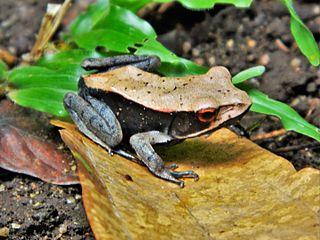
The bicolored frog or Malabar frog is a species of frog endemic to the Western Ghats of India. The tadpoles of the species are black and form dense and compact schools in slow moving streams in forested areas.

The fungoid frog or Malabar Hills frog is a colourful frog found on the forest floor and lower vegetation in the Western Ghats in south-western India from Bombay to Kerala. It is very similar to another species with which it overlaps partly in range, Hydrophylax bahuvistara which extends further into parts of central India. Although restricted in range within peninsular India, they are of least conservation concern. Their upper parts vary in colour from brownish-red to bright crimson.

Cyrtodactylus deccanensis, also commonly known as Deccan ground gecko, Günther's Indian gecko, or the banded ground gecko, is a species of gecko found in the northern Western Ghats of India. It has been found from northern Maharashtra, with a habitat range possibly extending to southern Gujarat. Cyrtodactylus albofasciatus was previously considered conspecific with Cyrtodactylus deccanensis but is now accepted as a valid species.

Duttaphrynus melanostictus is commonly called Asian common toad, Asian black-spined toad, Asian toad, black-spectacled toad, common Sunda toad, and Javanese toad. It is probably a complex of more than one true toad species that is widely distributed in South and Southeast Asia.

Duttaphrynus parietalis, commonly known as the Indian toad or ridged toad, is a species of toad found in the Western Ghats of India.

Indirana beddomii, Beddome's leaping frog, Beddome's Indian frog, or simply Beddome's frog, is a species of frog found in the Western Ghats. They are usually detected by their long leaps as they flush from the ground when disturbed. The species is named after the naturalist Richard Henry Beddome.

Duttaphrynus stomaticus, also known as the Indian marbled toad, Punjab toad, Indus Valley toad, or marbled toad, is a species of toad found in Asia from eastern Iran, Pakistan, Afghanistan to Nepal, extending into Peninsular India and Bangladesh.

The Malabar tree toad, or warty Asian tree toad, is a species of toad found in forests along the Western Ghats of great Karnataka or Deccan. It is a small species and is found in wet tree hollows or leaf bases containing water. It is the only species in the monotypic genus Pedostibes, also known as Asian tree toads.
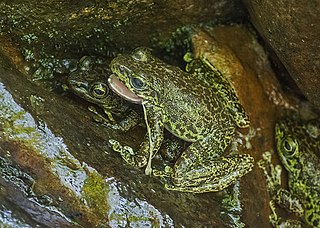
Amolops formosus, also known as Assam sucker frog, beautiful stream frog, Assam cascade frog, or hill stream frog, is a species of frog found in high gradient streams of northern India, northern Bangladesh, and Nepal, possibly also Bhutan, although these records may represent confusion between Amolops himalayanus and this species; the latest available IUCN assessment from 2004 treats A. himalayanus as a synonym of A. formosus.

Duttaphrynus microtympanum is a species of toad found in the Western Ghats of India, possibly wider.
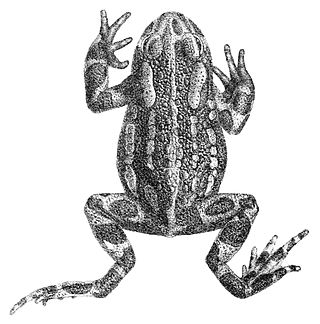
Pseudepidalea latastii is a species of toad found in the north-western Himalayas of India and Pakistan, where it lives between 2,600 and 3,000 metres.

Duttaphrynus beddomii is a species of toad endemic to the Western Ghats of India. It is found in Kerala and Tamil Nadu states in the southern Western Ghats at elevations of 100–1,500 m (330–4,920 ft) asl.
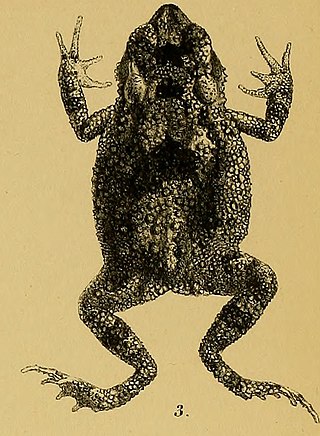
Ingerophrynus macrotis is a toad species of the family Bufonidae that is native to Cambodia, Laos, Malaysia, Myanmar, Thailand, Vietnam. Its presence in China is uncertain.
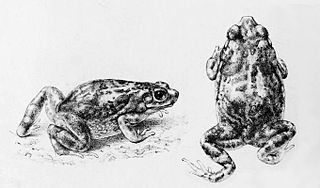
Duttaphrynus hololius, known as Günther's toad, Malabar toad, or rock toad, is an uncommon, rock-dwelling toad found in the Eastern Ghats and Deccan plateau of peninsular India.

Blaira ornata, known with common names ornate toad, Malabar torrent toad or black torrent toad, is a rare and endangered species of toad endemic to the Western Ghats. In 2009, this species along with A. rubigina was shifted from Ansonia to the genus Ghatophryne. The publication of the new genus however did not meet ICZN requirements and a new genus Blaira was created in 2021.

Duttaphrynus, named after Sushil Kumar Dutta, is a genus of true toads endemic to southwestern and southern China, Taiwan and throughout southern Asia from northern Pakistan and Nepal through India and Bangladesh to Sri Lanka, Andaman Island, Sumatra, Java, Borneo and Bali.

Blaira rubigina is a species of toad in the family Bufonidae. It is endemic to the southern Western Ghats, India, and is known from Silent Valley and Wynaad, both in Kerala. Its common names include Kerala stream toad, Silent Valley torrent toad, and red torrent toad.

Incilius melanochlorus, formerly Bufo melanochlorus, is a mid-sized species of toad with a crested head in the family Bufonidae. It is primarily distinguished by its very long first finger with respect to the other fingers. It is found in southern Nicaragua, in the northern Cordillera Central and on the Atlantic slopes of eastern Costa Rica, and in western Panama.

Scutiger spinosus is a species of toad in the family Megophryidae. It is found in Medog County, Tibet (China) and in Tawang district, Arunachal Pradesh (India). Prior to its description in 2016, it was confused with Scutiger nyingchiensis. Common name spiny lazy toad has been coined for it.






















